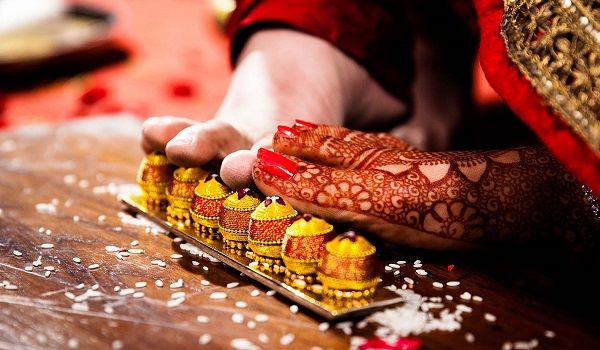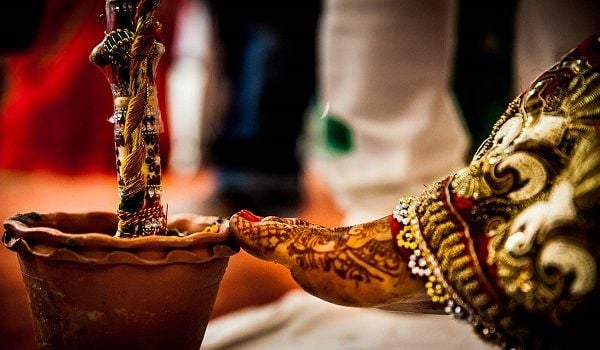
Image Source: Weddingstreet.in
Jainism is one of the prominent religions practiced in India. Maharashtra has the largest Jain population among all states followed by Rajasthan. Jains are a peace-loving community with deep sense of spirituality that guides their traditions. Jain weddings are typically simple although they involve a lot of intricate rituals that are governed by the strict Vivah Vidhi dictated by their religious texts. In Jainism, marriage is considered a worldly affair that increases human bondage, but it is encouraged nonetheless by the scriptures as it recognizes the dependence of two living organisms on one another. While certain traditions are sacrosanct to Jains, certain rituals are a result of regional and cultural influences. Jains prefer matches within their own community so that the traditions are carried forward. The practice of dowry is highly condemned by the entire Jain community. The weddings are conducted by a Jain Pandit preferably, but in certain cases it is also performed by a respectable person of the community who has proper knowledge of the entire process and its significance. Read on to know more about the wedding rituals of Jain marriage.
Swetambar vs. Digambar Traditions
The two main sects of Jainism differ somewhat in the marriage traditions they follow. According to Shwetambars, there are sixteen main rites in a marriage ceremony, which are – Matrkasthapana, Saptakulakarasthapana, Varaghodano Santimantra, Hastamelapa, Agnisthapana, Homa, Prathamabhisheka, Gotroccara, Mandapavedipratistha, Toranapratishtha, Agnipradaksina, Kanyadana, Vasaksepa,Dvitiyabhiseka, Karamocana, and Asirvada.
The Digambaras have a total of twenty prescribes rituals for their marriage ceremony – Vagdana, Vinayakvidhana, Kankanabandhana, Grhasamskara, Toranavidhi, Vivahavidhi, Parasparamukhavalokana, Varamala, Varapratijna, Kanyadana, Devasastragurupuja, Homahuti, Granthibandhana, Panigrahana, Saptapadi, Punyahavachana, Santimantra, Asirvada, Svagrhagamana and Jinagrhe Dhanarpana.
The Swetambar Jains are concentrated mainly in North India – Gujarat, Rajasthan and Uttar Pradesh while the Digambaras communities are mainly found in Maharashtra and Karnataka. Hence, the marriage rituals in Shwetambara Jains are mostly influenced by Hindu weddings rituals in North India and the wedding rituals of the Digambaras are influenced by that of South and Western India.
Thus, the marriage rituals among the Jains are not the same throughout India and vary considerably between communities and regions. Still the Jain Acharyas from both Svetambara and Digambara sects have tried to give uniformity to the marriage rites so far as their followers are concerned. In this way the prominent rites of the marriage ceremony are practically the same among Svetambaras all over India and the same is true about the Digambaras as well.
Pre-wedding Rituals

Image Source: Weddingphotosutra.com
Khol Barana and Tikka – In Marwari Jain communities like Agarwals, the rituals of Khol Barana and Tikka are practiced which mark the beginning of pre-wedding practices in the Jain communities. After the alliance has been finalized, the groom’s family visits the bride’s family with a silver platter containing a coconut and some cash. This is known as Khol Barana. Similarly, the bride’s family visits the groom’s house with gifts in a ceremony known as Tikka.
Laghana Lekhan – This ritual refers to a small puja that is conducted at the bride’s place and is attended by close relatives and friends. The Pandit decides upon the precise date and time of the wedding ceremony or Laghana.
Lagna Patrika Vachan – A letter is drafted in formal style where the date and time of the wedding as determined by the Pandit is written out. This letter is then sent out to the groom’s house. The groom performs the Vinayakyantra Puja and the letter from the bride’s side is opened. The Pandit reads out aloud for all assembled family members, relatives and friends to hear. This is known as the Lagna Patrika Vachan.
Manae Devaru Poojai – This is a special puja performed by Jains in South India before the wedding where a sacred pot is placed in deference to the deity and the family of both the bride and groom pray to the Almighty for wellbeing of the couple’s future as well as to conduct the marriage without any obstacle.
Sagai – Sagai refers to the formal engagement ceremony and is akin to the Tilak ceremony of the Hindus. The bride’s family visits the groom’s house and her brother applies a tika on the groom’s forehead signifying his acceptance to the family. Gifts and sweets are exchanged between the two families.
Mehendi – In Jain communities of Gujarat and Rajasthan, a Mehendi ceremony takes place. In this ceremony the bride’s hands and feet are adorned with elaborate and intricate designs with henna paste. Generally held a day or two before the actual wedding date, it is a fun event where all female members of the family get together to get henna applied to their hands.
Bana Betai – Bana Betai is observed by Marwari Jains of Rajasthan. It is the ritualistic bath before the wedding. Instead of Haldi or turmeric paste, the bride and the groom are anointed with chickpea flour or besan by the married women of their respective families. This is usually followed by a bath and the discarded clothes are given away.
Mada Mandap – Just before the wedding laghana, on the day of the wedding, a puja is performed by the Pandit, sanctifying the mandap or the spot where the wedding is to take place. This is known as Mada Mandap.
Thamba Prathistai and Kankanam Katusthathu – During this ritual a Sacred vessel is placed at the altar before God and a puja is conducted by the priest where he prepares special sacred thread called Kankanam. The Kankanam is then tied to the hands of the bride and the groom. After this ritual the bride and the groom should not see each other till the time of the wedding.
Wedding Attire
In Jain traditions, the groom wears a Kurta Pajama, which is now mostly replaced by a Sherwani and Pajama. Sherwanis are intricately designed long silk garments with a stiff collar and ornate buttons. He typically wears some jewelry around the neck like a long string of pearls and gold chains. In affluent families, a typical neck piece called ‘satladi’ is worn by the groom which is a seven tiered necklace made of pearls and emeralds. He must wear a headgear known as ‘safa’ in either dark red, maroon or saffron colors. The safa may be clipped with a brooch known as sarpach which again is embellished with precious stones like emeralds and pearls. He wears a pair of typical Indian sandals known as ‘mojri’.
For Jain weddings the bride may either wear a saree or a lehenga depending on family traditions and personal taste. In Jain weddings of Gujarat they generally wear sarees draped in typical Gujarati style. Among Marwari Jains, Lehenga is preferred. The lehengas range from simple ones to very intricate. Red is the preferred color although now other colors are also favoured. The bride is decked up in a lot of jewelry which may be gold or Kundan Jadau.
Wedding Rituals
Ghudhchadi – It is a ritual that is performed on the marriage day before the groom's procession leaves for the bride's place. The groom is given his headgear and his mother and all the relatives apply tika on his forehead. After this the groom rides the horse and visits a nearby temple to seek the blessings of the Almighty. The baarat or the groom’s procession is typical of Shwetambar Jains and this custom does not exist among the Digambars.
Barati – This refers to the receiving of the groom’s procession by the bride’s family. The bride’s brother and the groom exchange coconuts. The bride’s brother also gifts clothes, sweet and cash to the groom.
Aarti – The groom is then formally welcomed by the bride’s mother and other married female relatives who perform an Arti and sing traditional wedding folk songs known as Mangal Geet.
Kanyavaran – The bride is brought to the wedding mandap. The bride’s parents put one rupee and twenty five paise along with some rice on the bride’s right palm. They then present the bride to the groom who takes her hand in his own and the bride’s father makes a public proclamation of his daughter being married to the groom. The Pandit chants mantras while pouring water thrice over the couple’s hands.
Granthi Bandhan – A married woman from the family ties the ends of the bride and groom’s clothes together in a knot and prepares them for the Pheras.
Pheras – The Pheras are the most important of the Jain wedding rituals and they have to be performed at a predetermined time that is considered most auspicious. The couple circles the sacred fire four times where the bride walks ahead of the groom for the first phera and the groom ahead of the bride for the remaining three. While the Pheras are going on, the priest chants the Mahaveerashtak Strot and guests participate in singing the Mangal Geets. The Pheras are followed by taking of the seven vows of wedding which are as follows: The vows are:
1. To provide home with a nourishing and pure diet.
2. To develop physical, mental and spiritual powers.
3. To increase wealth by righteous means.
4. To acquire knowledge, happiness and harmony by mutual love and affection.
5. To be blessed by strong, noble and virtuous children.
6. To be masters of self-restraint and longevity, to work for the welfare of the family as well as the community.
7. To become true companions and retain a lifelong friendship with each other.
The bride then proceeds to sit on the left side of the groom and is now designated as a Vamangi which means she is now the better half of her husband. They exchange garlands and the wedding is concluded with a visarjan or formal way of putting out the sacred wedding fire.
Post-wedding Rituals

Image Source: goexplore-weddings.com
Ashirvada– After completion of the wedding rituals, the couple seeks blessings from the elders of both the families.
Bidaai – The bride departs from her parental home and is bid a tearful goodbye by her family.
Sva graha aagamana – This ritual refers to the bride’s arrival at the groom’s house. She is welcomed by her in-laws with much warmth and grandeur.
Jina grahe dhan arpana – this is a post-wedding ritual unique to Jains. The couple visits a Jain temple along with their respective families and distributes alms to the poor. This is done as a gesture of expressing gratitude to the God for successful completion of the wedding rituals and for blessing the families.
Reception – The reception is held by the groom’s family generally a day or two after the wedding. The extended family, relatives and friends are invited to meet and know the new bride and pass their blessings to the couple.




